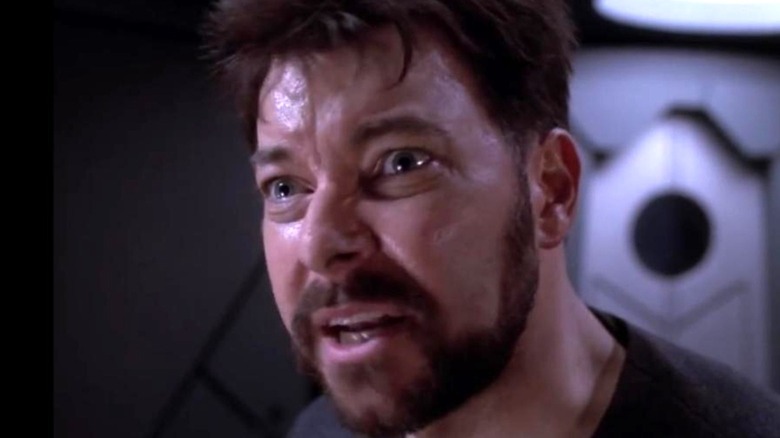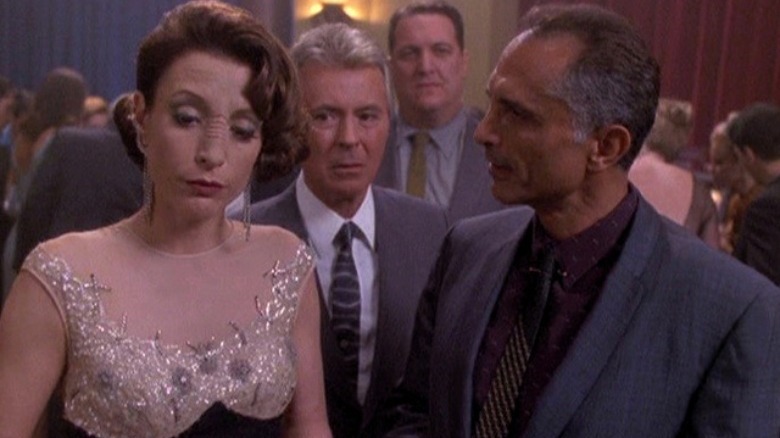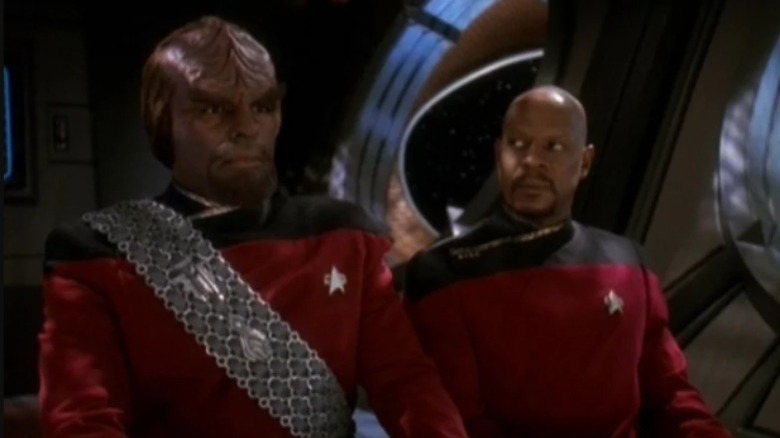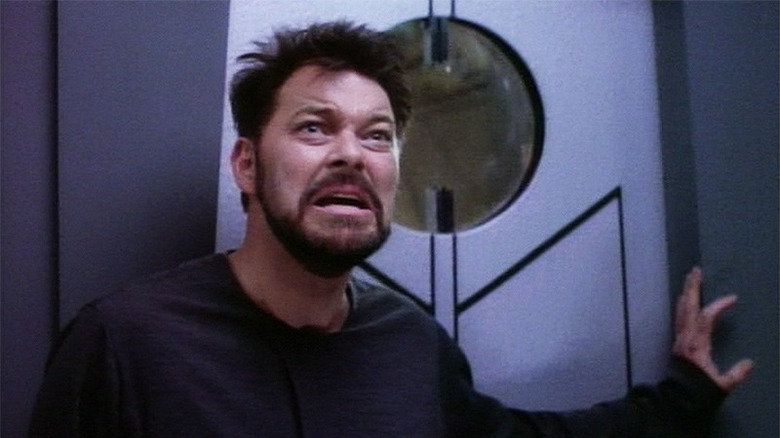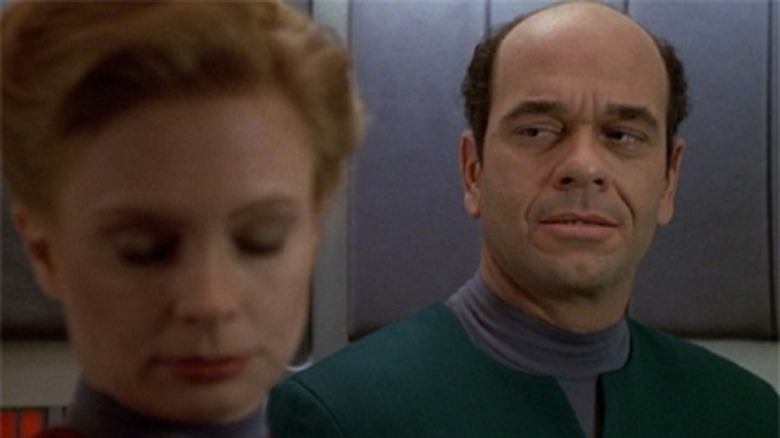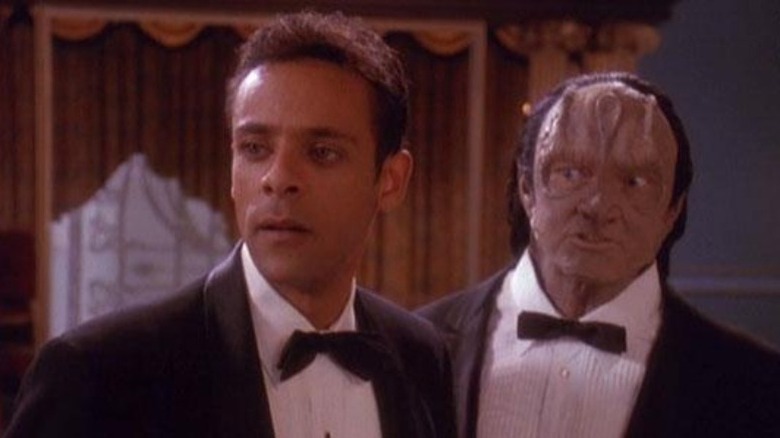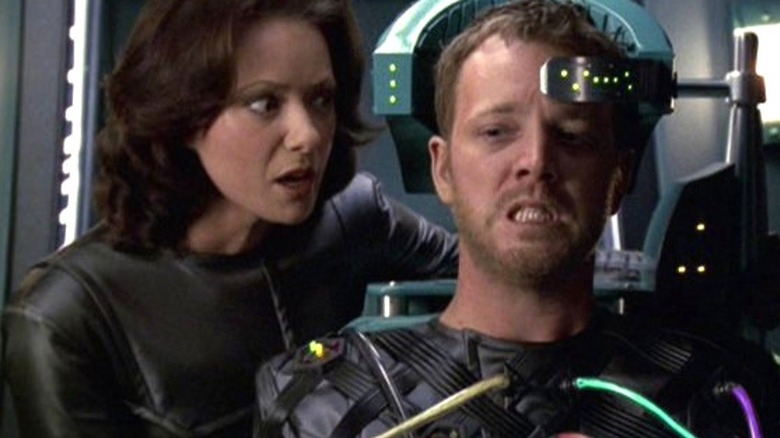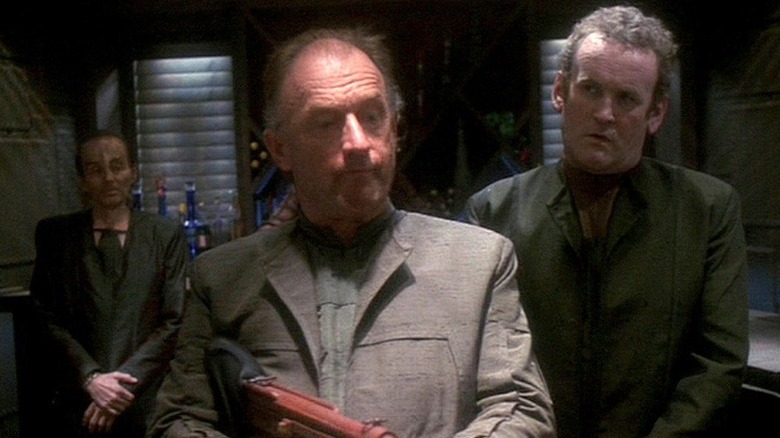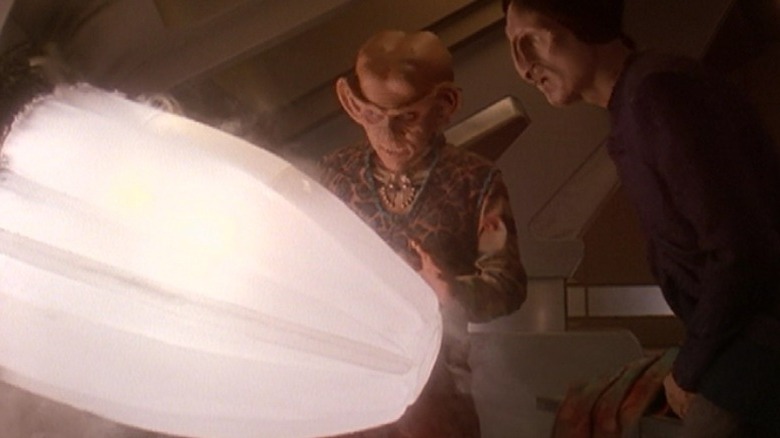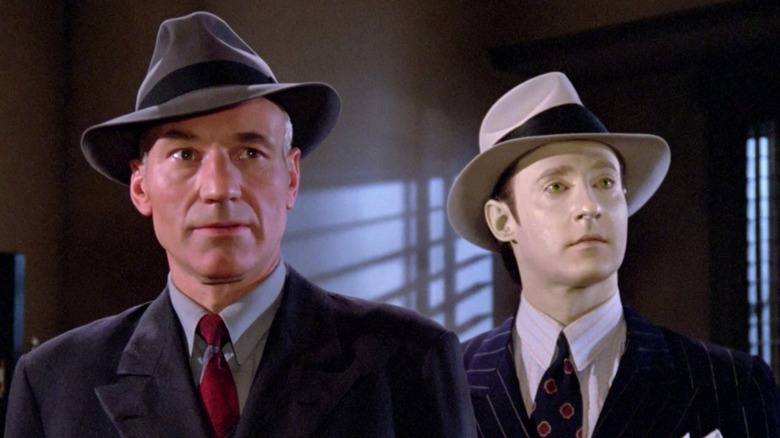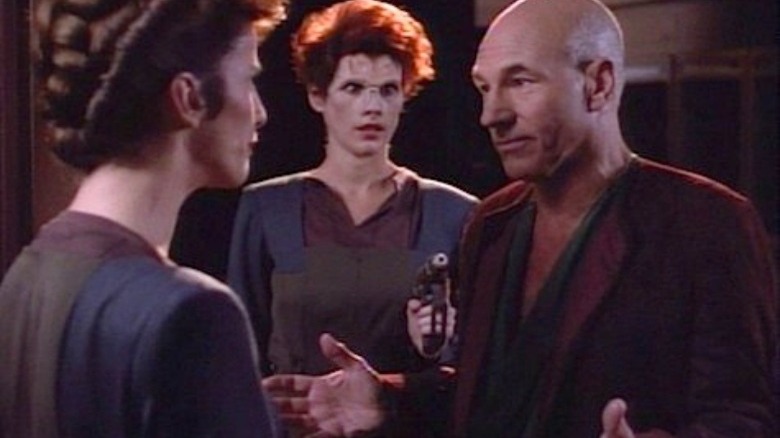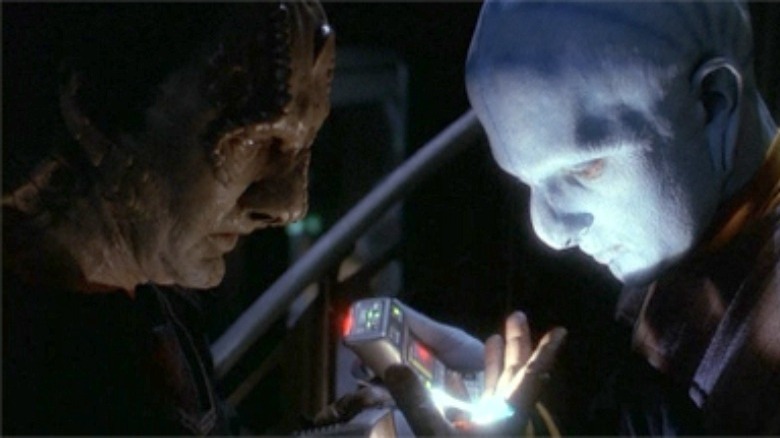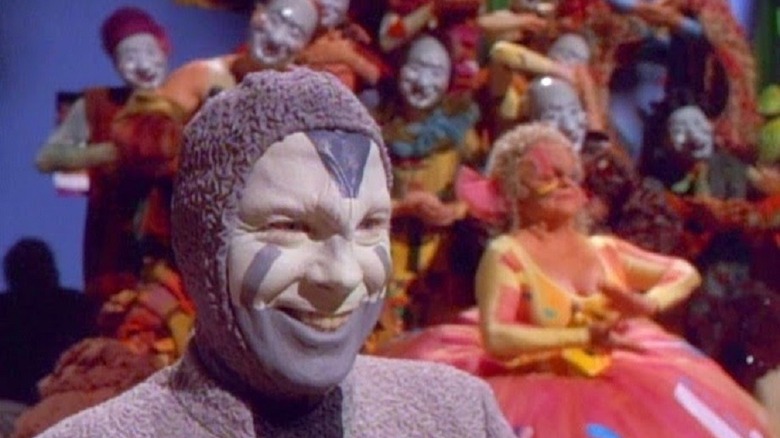Star Trek Episodes Inspired By Movies
Nothing is created in a void — not even in stories in which a void, literally, is the setting. Every director, writer, actor, and anyone else involved behind the scenes is inspired by those who have come before, often without even knowing it. Whether it's just a series of similar shots, a narrative storytelling tool, or a straight up conscious homage, creators borrow from each other all the time. "Star Trek" is no different.
Between the premiere of "Star Trek: The Original Series" in 1966 and the introduction of more recent shows like "Star Trek: Discovery" and "Star Trek: Picard," the various live-action "Trek" series have given fans over 30 seasons worth of stories. For that much storytelling, you need inspiration, and while you might not often recognize it, one of the franchise's favorite places to pull from is films — and often those films have nothing to do with space or even science fiction.
From episodes that drew from gangster dramas, classic horror stories, casino heists, and more, here are "Star Trek" episodes inspired by movies.
On the holodeck, DS9 remembers a classic heist film
Compared to "TNG" and "Voyager," "Star Trek: Deep Space Nine" doesn't have a lot of examples of the "Trek"-specific trope of holodeck-gone-wrong episodes. One of the few examples is the final season's "Badda-Bing, Badda-Bang," and the way things "go wrong" isn't like any other holodeck story.
Introduced in Season 6's "His Way," Vic Fontaine (James Darren) is a sentient holodeck character who acts as a lounge singer, Las Vegas casino owner, and often an adviser to the station's crew. In Season 7's "It's Only a Paper Moon," Quark (Armin Shimerman) agrees to run Vic's program all day, every day. Five episodes later, somehow Vic's program evolves to create the mobster Frankie Eyes (Frank Chalmers) and a small army of goons who take over Vic's club. Seeing Vic as their friend, the DS9 crew get together to plan a holodeck heist. They don't care about the holographic money, of course. Instead, they know that if enough money gets nabbed from under Frankie Eyes' nose, his boss Carl Zeemo (Marc Lawrence) will have a hole fitted for Frankie out in the holographic desert.
If the idea of a casino heist sounds familiar, that isn't a surprise. Preceding the 2001 remake starring George Clooney, Matt Damon, Brad Pitt and more, "Badda-Bing, Badda-Bang" unapologetically takes its inspiration from 1960's "Ocean's 11" starring Rat Pack legends Frank Sinatra, Dean Martin, and Sammy Davis Jr.
Rules of Engagement pulled from Akira Kurosawa
Because both are often portrayed as adhering to all-important codes of honor, some fans may understandably liken the Klingon warriors of "Star Trek" to depictions of samurai warriors. It's fitting, then, that in the Season 4 "DS9" episode "Rules of Engagement," the director took his cue from a classic samurai film.
When Worf (Michael Dorn) is accused of purposely destroying a Klingon transport filled with defenseless civilians, the Klingon Empire wants him extradited to face justice. In the proceedings that follow, we see the events from different points of view, during the testimonies of Worf, Quark, Captain Sisko (Avery Brooks), and Chief O'Brien (Colm Meaney). And not everyone's versions of events line up.
"TNG" alum Levar Burton directed the episode, and while being interviewed for the publication of 2000's "Star Trek: Deep Space Nine Companion" he said that when it came to showing the different testimonies, he took inspiration from Akira Kurosawa's 1950 film "Rashomon." Based on the 1922 Ryunosuke Akutagawa short story "In a Grove," Kurosawa's "Rashomon" unfolds after the death of a samurai. Just as in "Rules of Engagement," we see the different, contradictory stories from multiple points of view.
Frame of Mind took inspiration from a controversial director
It's Jacques in William Shakespeare's comedy "As You Like It" who utters the famous phrase "All the world's a stage." But in "Frame of Mind," it's Commander Riker (Jonathan Frakes) who experiences it firsthand.
The episode opens with Riker auditioning for the lead role in Dr. Crusher's (Gates McFadden) new play about a man imprisoned in an abusive mental institution. As the episode continues, it seems like life might be imitating art. Riker begins noticing strange looks from different crew members and suffers a pain in his head he can't explain. When he performs Crusher's play for the crew, instead of an audience, he finds himself facing an alien doctor who tells him he's not on the Enterprise, but in a mental hospital. Eventually returning to the ship, and then inexplicably to the performance of the play, Riker struggles to figure out what's real and what isn't.
In 1992's "Star Trek: The Next Generation Companion," Brannon Braga said he took a lot of inspiration from the 1965 film "Repulsion" while writing "Frame of Mind." Directed by the now-controversial director Roman Polanski, "Repulsion" stars Catherine Deneuve as Carol. Like Riker in "Frame of Mind," Carol questions reality while suffering horrific hallucinations involving sexual assault and other violence.
Darkling turns The Doctor into Mr. Hyde
There have been numerous film treatments of the 1886 Robert Louis Stevenson novella "The Strange Case of Dr. Jekyll and Mr. Hyde." Along with straight adaptations there are films clearly inspired by the concept, ranging from "The Nutty Professor" to "Incredible Hulk," and a version of the dual character appears in the 2003 Victorian-era superhero movie "The League of Extraordinary Gentlemen." In "Darkling" — a Season 3 episode of "Star Trek: Voyager" — it's the Doctor (Robert Picardo) who unintentionally creates a dark "Mr. Hyde" version of himself.
Much like Dr. Jekyll, the holographic Doctor has good intentions when he begins adding aspects of historical figures' personalities to his own. After all, who could imagine that adding attributes from Mahatma Gandhi and Leonardo da Vinci to yourself could cause any harm? As B'Elanna Torres (Roxann Dawson) soon discovers, however, the Doctor's experiments have destabilized his program, but she's too late.
By the time Torres discovers what's wrong, a new, darker version of The Doctor has emerged and it has no plans to be supplanted by what came before. Threatened by the notion that Kes (Jennifer Lien) might leave the ship, he attacks the alien courting her in secret, and eventually kidnaps Kes. He even uses his medical knowhow to paralyze Torres, hoping to get from her the information he needs to eradicate his original personality.
A memorable DS9 episode introduces us to Bashir, Julian Bashir
From the moment Julian Bashir (Alexander Siddig) first meets the enigmatic Garak (Andrew Robinson) in Season 1's "Past Prologue," the Starfleet doctor is fascinated with the exiled Cardassian spy and the espionage world from which he hails. They both get a strange taste of each others' worlds in the Season 4 "DS9" episode "Our Man Bashir."
While on a trip back to DS9, most of the station's senior staff are aboard a runabout that goes boom. They're beamed out of the ship just as it explodes, and their patterns are stuck in the transporter buffer while their images are somehow stored in the holosuite memory. While this is happening, Bashir and Garak are in the holosuite, running Bashir's favorite program clearly based on the James Bond films — particularly the ones from the '60s and '70s. Bashir's fellow officers begin appearing in the program as characters completely oblivious to anything but the spy story. For example, Kira Nerys (Nana Visitor) becomes Bashir's Russian lover, while Captain Sisko is the eccentric villain Hippocrates Noah. Warned to neither end the program or harm any of the characters — or else their patterns might be lost — Bashir and Garak are forced to play out the scenario to the end.
From Noah's ridiculous plot, to Duchamps' (Worf) knockout gas cigar and Bashir taking out a bad guy by popping a champagne cork, "Our Man Bashir" is a wonderfully fun homage to everything Bond.
In Alice, Tom Paris gets a taste of Stephen King
In Season 6 of "Voyager," the crew happens upon a space junkyard in "Alice." Separated from Starfleet and left without the usual limitless resources similar ships enjoy, it's the kind of place the Voyager crew could certainly use. Among the junkyard's assets is an advanced shuttle and Tom Paris (Robert Duncan McNeill) works hard to repair it.
While initially he promises Chakotay (Robert Beltran) to work on it only during his free time, soon the ship Paris has dubbed "Alice" is his only priority. He skips duty in sick bay in order to keep working on it, and snaps at B'Elanna when she tries to just touch it. We soon discover the ship is speaking to him even when he's not with it, and appears before him in the body of a humanoid woman only he can see. Soon, Paris is so obsessed with Alice (Claire Rankin) that he's willing to abandon Voyager and threaten the crew.
To fans of Stephen King's stories, "Alice" likely sounds pretty familiar. In 1983 John Carpenter directed "Christine," based on King's novel of the same name. Like Paris, awkward teenager Arnie (Keith Gordon) becomes obsessed with his new ride, but instead of a spaceship the object or Arnie's compulsion is a 1968 Plymouth Fury. While Christine never appears before Arnie as a woman, the possessed vehicle is even more homicidal than Alice, trying to kill anyone who bothers Arnie or pulls Arnie's attention away from it.
DS9 didn't fuggedaboutit
Who's worse — the crook, or the cop who lies to get the crook's trust? And ultimately, is there a difference between them? It's impossible to not consiuder those questions when watching the 1997 crime drama "Donnie Brasco." Johnny Depp stars as the titular FBI agent, who goes undercover to get dirt on the Bonnano crime family. Donnie successfully targets the aging crook Lefty (Al Pacino) to get access to the Bonnanos, and as he draws closer to paydirt he worries about the fate of his friend.
Chief Miles O'Brien gets a taste of Donnie's predicament in the Season 6 "DS9" episode "Honor Among Thieves." Released a year after "Donnie Brasco" to the month, "Honor Among Thieves" finds O'Brien recruited by Starfleet Intelligence to infiltrate the galaxy's most notorious crime organization, the Orion Syndicate. Using his technical know-how to impress the mid-level gangster Liam Bilby (Nick Tate), O'Brien gains his confidence. Bilby vouches for O'Brien to his superiors, who we ultimately learn are working with the Dominion. O'Brien eventually reveals himself to Bilby, in part hoping it will convince the crook to back off from a plot to assassinate a Klingon ambassador. Unwilling to put his family in danger, Bilby goes forward with his mission — and predictably is killed.
Starship Down had a number of cinematic inspirations
In the Season 4 "DS9" episode "Starship Down," the Defiant and her crew find themselves in the Gamma Quadrant to discuss the Federation's trade agreement with the Karemma — a minor member of the Dominion. During the talks, Sisko discovers Quark has been levying fake taxes on all trades between the Federation and Karemma and pocketing the extra proceeds. Before Sisko can make things right, the Jem'Hadar attack and cripple the ship, leaving all the various characters isolated in different sections of the Defiant while fighting to survive. Kira tries to keep an injured Sisko alive, Bashir and Jadzia (Terry Farrell) are trapped on a deck filled with deadly gas, while Quark and the trade minister he's been swindling (James Cromwell) try to disarm an undetonated Jem'Hadar warhead.
In the "Star Trek: Deep Space Nine Companion," David Mack — who co-wrote "Starship Down" with John J. Ordover — said originally the plan was to have the Defiant crash in an alien planet's sea. He likened it to the 1972 disaster film "The Poseidon Adventure," in which survivors of a capsized ocean liner struggle to escape before it sinks. Budget cuts changed the setting, while the story still focuses on the crew struggling to survive.
It's also impossible to watch "Starship Down" and not think of submarine movies like 1981's "Das Boot" and 1990's "The Hunt for Red October," and that's by design. Mack actually watched Wolfgang Petersen's "Das Boot" the night before pitching "Starship Down" to Ordover.
The Big Goodbye was also a big hello
In the first of what would become a long tradition of holodeck-gone-wrong episodes, Season 1 of "TNG" brings us "The Big Goodbye." Rather than a single film, "The Big Goodbye" is informed by the classic film noir entries based on the hardboiled fiction of Dashiell Hammett, Raymond Chandler, and others. Its title, in fact, is a mash-up of two classic Chandler novels which were both adapted to the big screen — 1939's "The Big Sleep" and 1953's "The Long Goodbye."
Stressed out by his mission to greet the Jaradan — a race of aliens so obsessed with the minutiae of diplomacy there's concern they might cut off all ties with the Federation or worse should Captain Picard (Patrick Stewart) speak his greeting to them incorrectly — Picard takes a well-deserved break on the holodeck in the guise of Philip Marlowe stand-in Dixon Hill. "The Big Goodbye" plays with the clashing tropes of "Star Trek" and film noir gloriously, creating what is easily the funniest episode in the series' inaugural season. In the virtual world full of hardboiled slang and colorful characters, Picard, Data (Brent Spiner), and Dr. Crusher come off like pampered tourists in an alien culture. While it's as predictable as it is inevitable, it's still hilarious to see Picard's reaction when he tries to smoke a cigarette and nearly collapses from the resulting coughing fit.
Yipee ki yay, Earl Grey drinker
In Season 6 of "TNG," Captain Picard makes like John McClane. The biggest difference? In 1988's "Die Hard," Bruce Willis' signature action hero gets in trouble after going to a party. Picard, on the other hand, gets in trouble while trying to sneak out of a party.
When the Enterprise makes a scheduled maintenance stop at a space station, Picard and his senior staff are all invited to a party with the station's commander, who is known for his tedium. Learning the planet the station orbits has horse trails, Picard returns to the ship to get his saddle, only to find unfamiliar people on his ship — which is supposed to be evacuated. Separated from his crew and learning the villains are there to steal trilithium resin, Picard goes to work McClane style. He uses his knowledge of the ship to trip up the thieves, as well as snagging some nasty weapons from Worf's quarters.
While the many parallels to "Die Hard" are obvious, screenwriter Morgan Gendel has tried to downplay the connection over the years, even though he freely admitted at the 2011 Phoenix Comicon that he pitched the episode as "Die Hard on the Enterprise." Gendel, by the way, has the distinction of writing two of the best Picard episodes of "TNG." Along with "Starship Mine," he wrote the Season 5 tearjerker "The Inner Light."
Empok Nor comes off like a John Carpenter classic
"Empok Nor" — taking place toward the end of Season 5 of "DS9" — sees some of its heroes in a struggle to the death against a character they've come to consider an ally.
Since DS9 was originally a Cardassian station, Chief O'Brien always struggles with finding replacement parts. So, along with Cadet Nog (Aron Eisenberg) and some of the engineering and security crew, he leads a mission to Empok Nor — an abandoned Cardassian station. He also recruits Garak, who he correctly assumes will have an easier time than he will when it comes to getting around Cardassian booby traps. Shortly after boarding Empok Nor, the Starfleet scavengers discover they're being stalked by a trio of Cardassian soldiers left behind in stasis. Garak deals with them but, affected by the same psychotropic drug that turned the other Cardassians into killing machines, Garak begins hunting and slaughtering the rest of his Starfleet companions, eventually kidnapping Nog in order to force O'Brien into a confrontation.
With its setting in a dark, remote station and the nature of the threat forcing acquaintances to distrust each other, the influence of the 1982 sci-fi/horror film "The Thing" is clear. Neither Garak nor anyone else turns into a gross, shape-shifting alien, but maybe they just didn't have the budget for it.
Voyager dealt with a clown that seemed familiar
Over two decades before Bill Skarsgård played the iconic horror villain, Tim Curry likely inspired more future cases of Coulrophobia — i.e. fear of clowns — than anyone or thing before with his portrayal of Pennywise the Clown in ABC's two-part TV movie "It" based on the Stephen King novel of the same name. Eventually revealed to actually be a massive spider-like creature from the stars, Pennywise wakes every 27 years to feed on the fear of the people of Derry, Maine — particularly the city's children.
While "Voyager" — like a lot of Trek series — is often said to have a rough first few seasons, one clear standout is Season 2's "The Thaw," in which Michael McKean guest stars in one his most menacing roles, as a character clearly based on Curry's fear-devouring Pennywise.
When the crew comes upon a planet with colonists in stasis pods, they discover the survivors' minds are active in some kind of virtual environment. Harry Kim (Garrett Wang) and B'Elanna Torres tap into the virtual world in hopes of reviving the colonists, only to discover they — and now the Voyager crew members — are hostages to a rogue artificial intelligence (McKean). Initially created to amuse the colonists during their long stasis, the artificial being — known simply as the Clown — instead keeps the survivors' minds to entertain itself. Completely in control of the virtual world, its favorite form of torture is to terrify the colonists, in some cases literally scaring them to death.
